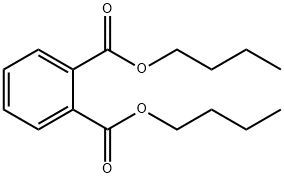
Dibutylphthalat
Bezeichnung:Dibutylphthalat
CAS-Nr84-74-2
Englisch Name:Dibutyl phthalate
CBNumberCB7161937
SummenformelC16H22O4
Molgewicht278.34
MOL-Datei84-74-2.mol
Synonyma
Dibutylphthalat
1,2-Benzoldicarbons?uredibutylester
Di-n-butylphthalat
Dibutylphthalat physikalisch-chemischer Eigenschaften
| Schmelzpunkt | -35 °C (lit.) |
| Siedepunkt | 340 °C (lit.) |
| Dichte | 1.043 g/mL at 25 °C (lit.) |
| Dampfdichte | 9.6 (vs air) |
| Dampfdruck | 1 mm Hg ( 147 °C) |
| Brechungsindex | n |
| Flammpunkt | 340 °F |
| storage temp. | 2-8°C |
| Löslichkeit | Very soluble in alcohol, ether, acetone, benzene |
| Aggregatzustand | Liquid |
| Farbe | APHA: ≤10 |
| Wichte | 1.049 (20/20℃) |
| Relative polarity | 0.272 |
| Geruch (Odor) | odorless |
| PH | 7 (20°C, 10mg/L) |
| Explosionsgrenze | 0.47%, 236°F |
| Wasserlöslichkeit | Slightly soluble. 0.0013 g/100 mL |
| FreezingPoint | -35℃ |
| Kennzeichnung gefährlicher | T,N,F |
| R-Sätze: | 61-50-62-39/23/24/25-23/24/25-11 |
| S-Sätze: | 53-45-61-36/37-16 |
| RIDADR | UN 3082 9/PG 3 |
| OEB | B |
| OEL | TWA: 5 mg/m3 |
| WGK Germany | 2 |
| RTECS-Nr. | TI0875000 |
| Selbstentzündungstemperatur | 756 °F |
| TSCA | Yes |
| HazardClass | 9 |
| PackingGroup | III |
| HS Code | 29173100 |
| Giftige Stoffe Daten | 84-74-2(Hazardous Substances Data) |
| Toxizität | Acute oral LD50 for rats 8,000 mg/kg (RTECS, 1985). |
| IDLA | 4,000 mg/m3 |
| 発がん性評価について | EPA D |


